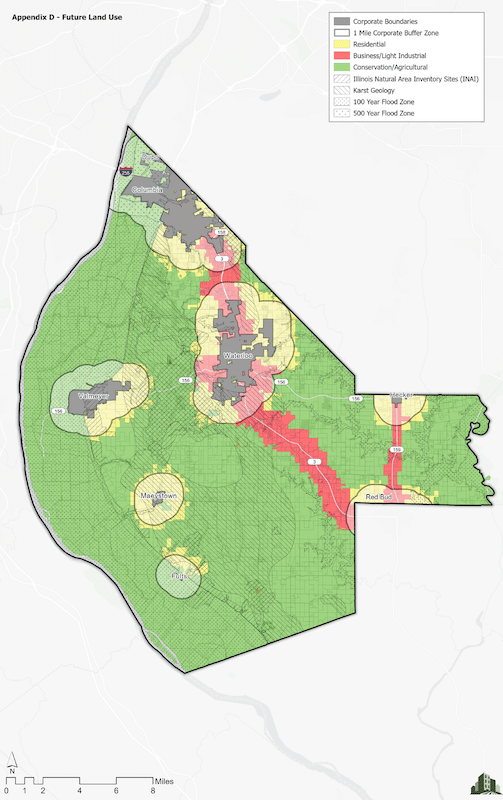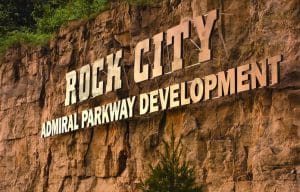Comprehensive plan advances

After roughly two years of effort, Monroe County could soon adopt a new comprehensive plan as the latest draft was recently approved by the committee and is set to move on to the planning commission next week.
Consideration for approval of this new comprehensive plan will take place at the commission’s Nov. 6 meeting at 7:30 p.m. in the west meeting room of the Monroe County Courthouse, with a public hearing on the plan also scheduled.
The final draft of the plan provided by the Monroe County Zoning & Building Department details the plan’s developments, key findings and goals, plus objectives identified following months of public input and committee deliberations.
Over the course of the plan’s development, committee members have emphasized the importance of nurturing the county’s rural, small-town feel while still encouraging the growth required to build and maintain infrastructure and the local economy.
As detailed in the plan, the county has five primary goals, the first being collaborating with and supporting individual communities.
Specific objectives within this wider goal include encouraging municipalities in Monroe County to establish their own comprehensive plans, supporting a diverse range of housing options, supporting infrastructure improvements, focusing county development efforts within existing municipalities rather than expanding into rural areas and generally promoting cooperation between local government bodies.
The plan’s second goal of preserving and restoring the county’s natural environment involves identifying and protecting conservation areas in the county, prioritizing stormwater management to address flood risk and improve groundwater quality, encouraging responsible use of renewable energy sources, protecting cultural and historic resources in the area and promoting tourism and use of the county’s open spaces and preserved areas.
Given the rural environment of Monroe County, supporting the agricultural sector is also a primary goal. The preservation and protection of land designated for agriculture is key, as is a requirement for developments to provide buffers between new projects and farmland.
The fourth goal concerns maintaining and improving quality of life in Monroe County by increasing access to diverse housing options in the area, enhancing community and recreational opportunities, maintaining rural infrastructure – including roads, utilities and high speed internet – and supporting first responders to maintain the area’s safe and low-crime environment.
Strategic growth and development is the final goal listed in the plan, with emphasis placed on encouraging new developments – be they commercial, industrial or residential – close to or within municipal boundaries, supporting the Monroe County Economic Development Corporation and planning for growth and development between Columbia and Waterloo.
While a number of specific strategies to meet all these goals and objectives are identified in the plan, as mentioned, general emphasis has been placed on preserving the current environment of Monroe County while allowing for growth and development as necessary.
To this end, one map included in the plan denotes future land use within the county. A one-mile corporate buffer zone is indicated around Waterloo, Columbia, Valmeyer, Hecker, Maeystown and Fults as well as area in the county near Red Bud.
This area seems largely intended for residential growth while rural areas throughout the county are identified for conservation or agricultural purposes.
In this spirit of keeping development near already developed areas of the county, land around major thoroughfares – namely Route 3 and Route 159 between Hecker and Red Bud – have been designated as ideal areas for business or light industrial development.
The goals of the plan were developed following a public engagement effort which included workshops with Comprehensive Plan Committee members, local elected officials and area stakeholders such as agribusiness and community sector representatives.
Public engagement also included an online survey which ran in the summer of last year, resulting in 794 participants. Input was also requested from community members who visited a booth at the 2024 Monroe County Fair.
Through this public input, the committee gleaned that Monroe County is projected to grow in population by 2-4 percent by 2028, having already grown 7 percent since 2010. This projection suggests roughly 9,700-17,400 new residents by 2050.
Concerning housing, a median household income of $105,352 was identified, and it was also noted that most homes in the area consist of modern houses built after 1990 – these largely being single-family detached homes. A need was seen for entry-level and senior housing.
On economic development, it was noted two-thirds of county jobs are white-collar though agriculture is still a major industry in the county. Over half of working residents, the plan says, commute outside the county for work, largely to St. Louis or St. Clair County.
Regarding transportation, the importance of I-255, Route 3 and other major thoroughfares was emphasized along with the need to support transit infrastructure and agencies such as the Monroe-Randolph Transit District.
The county’s natural resources and open space are also discussed in the plan, which identifies the many caves and sinkholes in the area and the role conservation groups like Clifftop play in caring for natural areas.
Several members of the Comprehensive Plan Committee offered their thoughts on the current draft, including Carl Daubach, who has been involved in the committee’s efforts for the past 12 years, having a hand in the previous update to the comprehensive plan.
He noted the plan simply serves as a vision for county development over the next decade. Daubach also discussed some of the major points of emphasis contained within the plan, including emphasis placed on development around major thoroughfares.
“That’s a little bit of a change from the previous 10-year and 20-year versions in that mostly it was simply an annexing and expansion on the part of the two biggest communities, Columbia and Waterloo, and some degree of expansion with Valmeyer and maybe Hecker,” Daubach said. “But now it tends to be more focused along those major corridors.”
He further spoke about the emphasis locals placed on maintaining this county’s natural areas.
“A large segment of the county appears agriculture, but there has been a desire among people to have more natural areas open to public visitation such as Salt Lick Point, White Rock Nature Preserve, Wightman Nature Preserve, Fults Hill Prairie Nature Preserve,” Daubach said. “Those seem to be more enamored on the part of the public as valuable resources, and they want more of them.”
Dan Davis also spoke about the shift in areas seemingly geared toward development, particularly noting how the area between Red Bud and Hecker has been newly identified as a place for potential business or light industrial purposes.
“Basically, most citizens want steady, slow growth, they want to try to maintain that agricultural feeling, but they realize we need to have some growth in order to maintain our infrastructure and keep our people here,” Davis said.
Dennis Brand expressed similar sentiments, reiterating the importance of growth while maintaining Monroe County’s current identity.
“It’s really to protect the county here, the type of growth and how much growth, protect the areas that need to be protected for the future,” Brand said. “Get growth, but not go crazy.”
The final draft of the comprehensive plan will be reviewed by the planning commission at the Nov. 6 meeting following a public hearing, at which point the plan will be approved, tabled or have changes recommended.
The plan then goes before the Monroe County Board.






